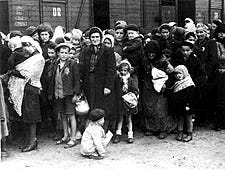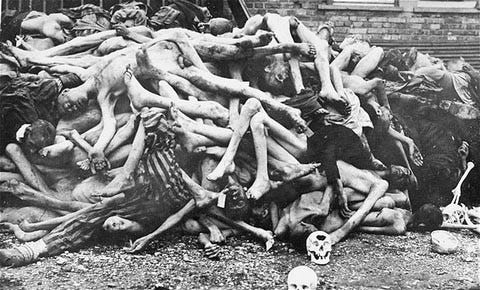A Dictionary from Hell: Wicked Imaginations & False Witnessing
Stories We Tell Ourselves or Stories We Are Ourselves, Part Five
“These six things doth the LORD hate: yea, seven are an abomination unto him: A proud look, a lying tongue, and hands that shed innocent blood. A heart that deviseth wicked imaginations, feet that be swift in running to mischief. A false witness that speaketh lies, and he that soweth discord among brethren.” (Proverbs 6: 16-19)
“Thou dost not answer against thy neighbour a false testimony.” (Exodus 20:16, 9th commandment)
Narrative-Shaped Facts Vs Fact-Shaped Narratives
“Both the Höfle Telegram and the Korherr Report . . . used the language of movement: arrival and increases, deportation and evacuation. One requires a ‘dictionary from Hell’ to transcribe that into the language of mass murder.” —Nick Kollerstrom, Breaking the Spell (p. 231-32)
Last week, I examined the assumption-slash-lie of the 2001 HBO-BBC film Conspiracy, in depicting the Wannsee Conference of 1942 as the place and time that the mass extermination of the Jews was plotted and greenlit by the National Socialist German Worker’s Party in Germany.
As it turns out, this assumption-lie extends well beyond the parameters of entertainment-propaganda, into outright propaganda (i.e., “official” information on the Holocaust™). For example this, from the Holocaust Encyclopedia, official site of the United States Holocaust Memorial Museum:
Among the most crucial documents submitted as evidence at Nuremberg was the Wannsee Conference Protocol. This document is one of the most important surviving German documents on the Holocaust. It comprises the carefully revised minutes of the Wannsee Conference (January 20, 1942), chaired by Reinhard Heydrich, at which he outlined the expansion of Nazi mass murder to encompass 11 million Jews in Europe. The Protocol was compiled, and heavily edited, by Adolf Eichmann from notes taken during the meeting. It identifies not only the participants at the conference, but their agreement to collaborate on a continental scale in the “Final Solution to the Jewish Question,” in other words, mass murder.
Was ever a phrase more efficiently designed for a narrative leap of wicked imagination than “in other words . . .”? To make it still more explicit, this is from the site’s Wannsee conference page:
Despite the euphemisms which appeared in the protocols of the meeting, the aim of the Wannsee Conference was clear to its participants: to further the coordination of a policy aimed at the physical annihilation of the European Jews.
Clear to its participants how, exactly?
(I could find no link at the site either to the actual document or to a translation of it.)
Last week I outlined the problem of “a pre-existing narrative shaping the facts, rather than facts being allowed to shape a narrative.” In my opinion, this is the key to understanding how false narratives operate; wherever such a “mechanism” can be shown to be at work, it suggests a false narrative hidden behind it.
Since I began looking into the Holocaust narrative, I have been struck by how single phrases and images are used to suggest evidence of the Nazi mass-extermination plan™, when, objectively viewed, they are quite neutral. Jews being herded onto trains, for example, when referenced in the context of World War Two, immediately invokes for most people both malevolence and tragedy. At the Wikipedia page for Holocaust denial, there is a picture of people gathered outside a train carriage, with the caption “Jews on selection ramp at Auschwitz, May 1944.” It almost seems meant as a reprimand to all those Holocaust deniers, as if the image itself were proof of something . . . besides people gathered outside a train carriage.
One of the most indelible images that we have all seen is of masses of emaciated bodies in piles, sometimes being moved by bulldozers, at one or other of the internment camps. (The image below was taken at Dachau.) For most people, such footage is irrefutable evidence of the Holocaust™. Yet even if we can be sure such footage was taken when and where it is claimed it was, all it is proof of is masses of emaciated dead bodies, not of how or why or when they died (or what their race or religion might be).
How do we know the bodies were not victims of a typhus epidemic, of which there were many? Or of starvation due to food shortages towards the end of the war? It may be an indication of how firmly the wickedness of the Holocaust narrative has taken hold over our imaginations, if such explanations strike us as somehow less probable than mass extermination by gas chambers.
Sacred Numbers
“All the hype notwithstanding, there is no evidence that Holocaust deniers exert any more influence in the United States than the flat earth society does. Given the nonsense churned out daily by the Holocaust industry, the wonder is that there are so few skeptics. The motive behind the claim of widespread Holocaust denial is not hard to find. In a society saturated with The Holocaust, how else to justify yet more museums, books, curricula, films and programs than to conjure up the bogy of Holocaust denial? Thus Deborah Lipstadt’s acclaimed book, Denying the Holocaust, as well as the results of an ineptly worded American Jewish Committee poll alleging pervasive Holocaust denial, were released just as the Washington Holocaust Memorial Museum opened.” —Norman Finkelstein, The Holocaust Industry (p. 68)
As Finkelstein’s book (first published in 2000) shows, that the Holocaust™ is a massive industry is a provable fact. While in no way insinuating the unreality of an extermination program of Jews, it certainly raises the necessity of reconsidering the narrative around it.
Disclaimer: I do not know all the facts (or the assumptions, exaggerations, and inventions) that make up the Holocaust narrative. No one does. All I know is that such a narrative exists; that it has been assembled out of some facts and at the exclusion of others; and that it appears to include some non-facts (also known as errors, inventions, embellishments, or lies) in there too.
Dupont’s The Myth of the Wannsee Conference: A Study of the Wannsee Conference Minutes includes a photograph of an original National Socialist document listing the numbers of Jews in the various European countries, both National Socialist-occupied and not.
As detailed above, of the 6.7 million Jews estimated by the Nazis themselves to be in the category “B” countries [Bulgaria, England, Finland, Ireland, Italy, Albania, Croatia, Portugal, Rumania, Sweden, Switzerland, Serbia, Slovakia, Spain, Turkey (European portion), Hungary, USSR (including the Ukraine and Byelorussia)]; almost none actually fell into German hands. The category “A” country figure of 4.5 million Jews [in Germany, Austria, Eastern territories, General Government, Bialystok, Protectorate Bohemia and Moravia, Estonia, Latvia, Lithuania, Belgium, Denmark, France, Greece, Netherlands, Norway] can therefore be taken as the most reliable estimate of the number of Jews who actually fell into Nazi hands, give or take a few hundred thousand. This is where the figures get interesting: the figure of 4,536,500 Jews is important when it is considered that, until the end of 1987, some 4,384,138 individual claims for compensation had been made by Holocaust survivors against the post war German government. This means, by the Nazis’ own reckoning, that of the estimated 4.5 million Jews directly under their control in 1942, at least 4.3 million had claimed compensation from the German government for persecution by 1987. These figures by themselves speak volumes about the true number of Jewish casualties during the war (p. 14-15).
If these numbers are accurate—and if the original document is authentic—then “six million Jews” begins to look like an unlikely, or a mythical, number. Yet this number is central to the Holocaust narrative, and in defining the single most “significant” historical event of the 20th century.
There are other sources for this inflammatory idea. According to historian and “Holocaust denier” John Wear, a New York Jewish publication named Aufbau “documented that on June 30, 1965, 3,375,000 inmates, the vast majority of whom were Jewish, had survived the German camps and were receiving reparations from Germany.” (I couldn’t track this to its source, however.)
Norman Finkelstein again, in The Holocaust Industry, put it more pithily (and wryly):
The postwar German government provided compensation to Jews who had been in ghettos or camps. Many Jews fabricated their pasts to meet this eligibility requirement. “If everyone who claims to be a survivor actually is one,” my mother used to exclaim, “who did Hitler kill?” (p. 81)
Over several decades of hearing about the Holocaust™, I, like many, have naïvely assumed that the many sad testimonials of Jewish survivors of World War Two were motivated by the simple desire to speak out about a terrible tragedy. I never knew, as few people know to this day, that “in the early 1950s Germany entered into negotiations with Jewish institutions and signed indemnification agreements. With little if any external pressure, it has paid out to date some $60 billion.” (Finkelstein, The Holocaust Industry, p. 84; that number is a lot higher twenty years later).
This raises more than one awkward question. If millions of Holocaust survivors told porky pies to bring home some bacon (creating a billions-of-Deutschmark-a-year “Holocaust industry” that continues to thrive today), the question isn’t just, “How did so many survive an extermination drive?” It is also, “How can such handsomely-paid testimonials be trusted?”
As a comparison point, imagine if eye-witnesses in a murder case were paid in cash for their stories, and the grislier the story, the bigger the paycheck? How would that affect the administration of justice?
It would seem that there are so many Holocaust survivors on record, whether now (almost eighty years later) dead or (miraculously) still alive, that, if they were all genuine, their testimonies would constitute proof that the Holocaust never happened, that “the Final Solution” was an extermination plan that exterminated nobody.
Yet if they are not genuine, it also throws into question the entire basis for the Holocaust narrative. It is a classic double-bind: to affirm the Holocaust is to deny the Holocaust.
It may even be, ironically, and as Finkelstein suggests, that, at this stage in history, the specter of “Holocaust denial” is the one thing that is most effectively keeping the Holocaust narrative alive?







